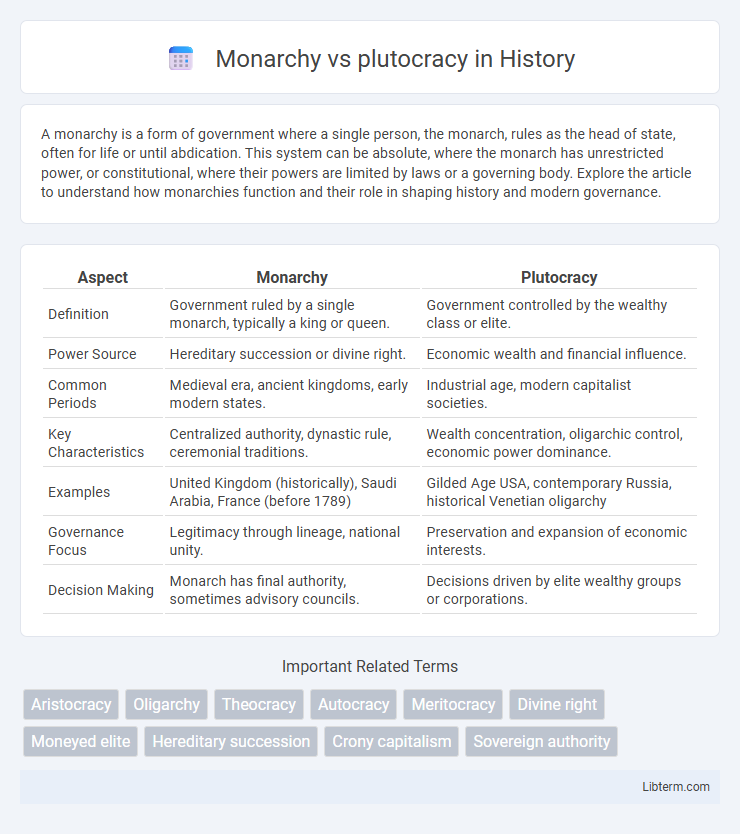A monarchy is a form of government where a single person, the monarch, rules as the head of state, often for life or until abdication. This system can be absolute, where the monarch has unrestricted power, or constitutional, where their powers are limited by laws or a governing body. Explore the article to understand how monarchies function and their role in shaping history and modern governance.
Table of Comparison
| Aspect | Monarchy | Plutocracy |
|---|---|---|
| Definition | Government ruled by a single monarch, typically a king or queen. | Government controlled by the wealthy class or elite. |
| Power Source | Hereditary succession or divine right. | Economic wealth and financial influence. |
| Common Periods | Medieval era, ancient kingdoms, early modern states. | Industrial age, modern capitalist societies. |
| Key Characteristics | Centralized authority, dynastic rule, ceremonial traditions. | Wealth concentration, oligarchic control, economic power dominance. |
| Examples | United Kingdom (historically), Saudi Arabia, France (before 1789) | Gilded Age USA, contemporary Russia, historical Venetian oligarchy |
| Governance Focus | Legitimacy through lineage, national unity. | Preservation and expansion of economic interests. |
| Decision Making | Monarch has final authority, sometimes advisory councils. | Decisions driven by elite wealthy groups or corporations. |
Introduction: Defining Monarchy and Plutocracy
Monarchy is a form of government where a single ruler, typically a king or queen, holds supreme authority, often inherited through a royal lineage. Plutocracy refers to a system of governance dominated by the wealthy elite, where political power is concentrated among individuals with significant economic resources. Both systems influence societal structure and decision-making but differ fundamentally in the source and legitimacy of their authority.
Historical Origins of Monarchy and Plutocracy
Monarchy traces its origins to ancient civilizations such as Egypt and Mesopotamia, where centralized authority was vested in a single sovereign, often justified by divine right. Plutocracy emerged in ancient Greece and Rome, characterized by rule dominated by wealthy elites who used their economic power to influence political decisions. Both systems developed as responses to social hierarchies and the concentration of power in distinct societal classes.
Key Characteristics of Monarchies
Monarchies are characterized by a single sovereign ruler, often inheriting power through a royal lineage, with authority ranging from absolute to constitutional limits. Key features include centralized control, symbolic national unity, and often a ceremonial role that upholds traditions and continuity within the state. Monarchies contrast with plutocracies, where governance is dominated by wealthy elites rather than hereditary rulers.
Core Features of Plutocracies
Plutocracies are characterized by the concentration of power and wealth in the hands of a small elite, where economic status directly influences political control. Unlike monarchies, where authority is inherited through royal lineage, plutocratic systems grant governance based on financial influence and assets. This economic dominance results in policy-making that primarily benefits the affluent, often marginalizing broader democratic participation.
Governance Structures Compared
Monarchy features a centralized governance system led by a single ruler, often hereditary, ensuring continuity and centralized decision-making authority. Plutocracy concentrates power in the hands of a wealthy elite, where governance decisions favor financial interests and economic influence. Both diverge in accountability mechanisms, with monarchy relying on dynastic legitimacy while plutocracy depends on wealth-driven control over political institutions.
Power Distribution and Social Hierarchies
Monarchy centralizes power in the hands of a single sovereign, often legitimized by hereditary rule, creating a clear vertical social hierarchy with nobles typically subordinated to the monarch. Plutocracy distributes power among the wealthiest individuals or families, establishing an oligarchic structure where economic capital dictates social status and political influence. In monarchies, power is formalized through traditional institutions, whereas in plutocracies, wealth-driven networks and financial clout shape social stratification and governance.
Impact on Economy and Wealth Distribution
Monarchy often centralizes economic control and wealth within a ruling family or nobility, potentially leading to limited social mobility and unequal wealth distribution. Plutocracy concentrates power and economic influence in the hands of the wealthy elite, intensifying wealth disparities and shaping policies that favor capital accumulation. Both systems typically result in economic structures where wealth distribution favors a select few, impacting broader economic growth and social equity.
Public Participation and Political Stability
In monarchies, public participation is often limited as power is concentrated in a single ruler or royal family, which can sometimes result in political stability through centralized decision-making and tradition. Plutocracies, where wealth dictates political influence, tend to restrict public participation to elite groups, potentially causing social unrest and instability due to economic inequality. Both systems face challenges in balancing concentrated power with inclusive governance, impacting long-term political stability.
Case Studies: Notable Monarchies and Plutocracies
The British Monarchy exemplifies a stable constitutional monarchy with a hereditary crown and parliamentary democracy, while Saudi Arabia represents an absolute monarchy with centralized royal authority. In contrast, the United States illustrates a plutocratic influence in its political landscape, where wealth and corporate power shape policy decisions despite democratic institutions. Historical plutocracies include Renaissance Venice, where merchant elites controlled governance, reflecting significant economic dominance over political structures.
Modern Relevance and Future Prospects
Modern relevance of monarchy persists in constitutional forms where symbolic authority coexists with democratic governance, ensuring national unity and cultural continuity. Plutocracy increasingly influences policy through wealth concentration, raising concerns about democratic erosion and social inequality as elite economic power shapes legislation and access. Future prospects suggest monarchies may evolve into purely ceremonial roles, while plutocratic dynamics could intensify unless regulatory frameworks enhance economic equity and political transparency.
Monarchy Infographic

 libterm.com
libterm.com